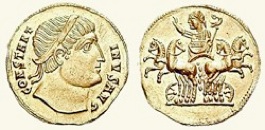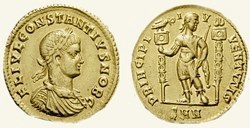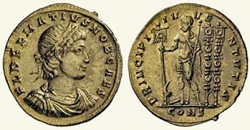Constantinople
CONSTANTINVS AVG
RIC VII Constantiniple 1 or similar (ca. 324 AD)
On 8th November 324 AD, shortly after his victory over Licinius, Constantine consecrated his new capital at on the ancient Greek city of Byzantium, which he renamed Constantinopolis, the ‘city of Constantine’. It was formally dedicated in May 330 AD. As we shall see below, Constantine chose to celebrate his Tricennaliahere, rather than in Rome, in 336 AD.
Constantius as Caesar (324 AD)
FL IVL CONSTANTIVS NOB C
PRINCIPI IVVENTVTIS
RIC VII Nicomedia 76 (ca. 324 AD)
After his defeat of Licinius, Constantine continued to develop his dynastic imperial college by appointing his third son, the seven year old Constantius as Caesar. The ruling college now comprised Constantine and the three Caesars: Crispus, Constantine junior and Constantius. Constantine also raised his wife, Fausta, to the rank of Augusta at about this time.
Vicennalia (326 AD)
Constantine celebrated his vicennalia on July 25, 325 AD. At this time, he seems to have been preoccupied with the consolidation of his position in the eastern territories recently lost to him by Licinius He was thus in Nicomedia when the anniversary fell due, and did not celebrate it in Rome until the end of this twentieth year of his reign.
The visit must have been overshadowed by the execution of Crispus and the mysterious death of Fausta (discussed below). According to Zosimus:
-
“And on a particular festival, when the army was to go up to the Capitol, [Constantine] very indecently reproached the solemnity and, treading the holy ceremonies, as it were, under his feet, he incurred the hatred of the senate and people” (‘New History’, 2:19, search on ‘treading’).
This is usually taken to mean that Constantine refused to participate in the rites at the Capitoline Temple during the vicennalia.
Constantine left Rome. probably in September 326 AD, never to return.
Deaths of Crispus and Fausta (326 AD)
Crispus’ status had been raided considerably when he had commanded the fleet that had defeated Licinius in the Battle of Chrysopolis, which had been decisive in pushing the war in Constantine’s favour. Constantine seems to have tried to contain his ambitions by elevating Constantinnius and Fausta. The tensions in the dynastic college at this time led to tragedy. Crispus was tried and executed at Pola (now Pula, in Croatia): Lars Ramskold (referenced below) has published a newly discovered coin that had been minted in Rome for Crispus, from which he deduced that Crispus was executed soon after Constantine’s arrival in Rome for the vicennalia.
As Johannes Wienand (referenced below, at pp. 227-8) observed:
-
“The so-called ‘Palace Crisis’ of early 326 AD culminated in the execution of Constantine’s oldest son Crispus. Constantine’s wife, Fausta, and a series of Crispus’ retainers were also killed in the course of the crisis. Constantine appears to have emerged from it stronger than before, but the conflict destroyed his original dynastic plans and forced him to realign his entire imperial house. In order to reconstruct a fully functional imperial system, Constantine found himself forced to integrate members of the lateral line of his family descended from Theodora into his domus divina ...”
Evolution of the Imperial College (333-6 AD)
FL CONSTANS NOB CAES L DELMATIVS NOB CAES
CONSTANS NOB CAESAR DELMATIVS CAESAR
RIC VII (Constantinople) 97 (ca. 333AD) RIC VII (Constantinople) 98 (ca. 335AD)
Constantine appointed his third surviving son, the ten year old Constans, as Caesar in 333 AD. The dream articulated for Constantine in Panegyric IV (translated into English in Nixon and Rodgers, referenced below) some two decades earlier comes to mind here:
-
“... the future will truly be blessed if, when you have installed your sons at the helm of the world, you are the greatest Emperor of all” (26:5)
In 335 AD, Constantine created is nephew, Flavius Dalmatius (or Delmatius) as the fourth Caesar, perhaps in active preparation for his own demise.
The respective territories of the four Caesars are illustrated in this map (part of a brilliant on-line resource published by Ian Mladjov, University of Michigan).
Death of Constantine (337 AD)
The aged Constantine planned a last great campaign, one which was intended to conquer Persia. These plans came to nothing in the spring of AD 337, when Constantine became dangerously ill. He died on 22 May AD 337 at the imperial villa at Ankyrona at Nicomedia. Constantius, the nearest of the Caesars arrived soon after and escorted his father’s body to Constantinople.
According to Eusebius of Caesarea:
-
“On the arrival of the news of [Constantine’s] death in [Rome], the Roman senate and people felt the announcement as the heaviest and most afflictive of all calamities, and gave themselves up to an excess of grief. The baths and markets were closed, the public spectacles, and all other recreations in which men of leisure are accustomed to indulge, were interrupted. ... Nor was their sorrow expressed only in words: they proceeded also to honour him, by the dedication of paintings to his memory, with the same respect as before his death. The design of these pictures embodied a representation of heaven itself, and depicted the emperor reposing in an ethereal mansion above the celestial vault. They also declared his sons alone to be emperors and Augusti, and begged with earnest entreaty that they might be permitted to receive the body of their emperor and perform his obsequies in the imperial city” (‘Life of Constantine’, 4:69).
This entreaty from the Romans was to be denied:
-
“[Constantius] ... proceeded to celebrate his father's funeral in [Constantinople] ..., himself heading the procession, which was preceded by -detachments- of soldiers in military array, and followed by vast multitudes, the body itself being surrounded by companies of spearmen and heavy armed infantry. On the arrival of the procession at the[Church of the Holy Apostles, which Constantine had consecrated in ca. 330 AD], the coffin was there entombed. Such honour did the youthful emperor Constantius render to his deceased father, both by his presence, and by the due performance of this sacred ceremony” (‘Life of Constantine’, 4:70).
Aurelius Victor, who was probably in Rome at this time, gave a less dramatic and probably more accurate account of the Romans’ reaction:
-
“[Constantine’s] body was carried back to Constantinople for burial]. This certainly upset the Roman people very seriously ...” (‘de Caesaribus’, 41:18)
Succession
Constantine remained officially regnant after his death, presumably because the succession was contested. Eusebius was at pains to gloss over the intervening events, but it seems clear that one or more of Constantine’s sons conspired to murder Dalmatius and his close relatives, including his father Julius Constantius (Constantine’ half-brother and, in some sense now the head of the family). Richard Burgess (referenced below, at p. 10)) concluded that these murders were carried out in early June, when Julius Constantius, Dalmatius and other members of the family that were based at Naissus were probably still in Constantinople following the funeral.
The list of casualties extended beyond the Imperial family: Richard Burgess (referenced below, at p. 10) deduced that they also included:
-
“Flavius Optatus, patricius and Consul of 334 AD; Flavius Ablabius, Praetorian Prefect of the East and Consul of 331 AD; and ‘many nobles’, who probably included Aemilius Magnus Arborius and possibly Virius Nepotianus and Flavius Felicianus”.
The case of Flavius Ablabius is particularly interesting: as Richard Burgess (referenced below, at p. 9) pointed out:
-
“Flavius Ablabius, was assigned to Constantius [as his Preatorian Prefect] after Constantine’s death (probably in Constantine’s will), a relationship in which he was clearly intended to act as guardian and advisor; Ablabius’ daughter, Olympias, had earlier been betrothed to Constans.”
It seems likely that he had tried to arrange the succession in line with the will of Constantine, without paying due attention to the aspirations and intentions of Constantius II.
Finally, on 9th September 337 AD, some seven weeks after Constantine’s death, his three surviving sons met at Sirmium, where the Danubian army proclaimed them as Augusti:
-
✴Constantine II, for Gaul, Spain and Britain;
-
✴Constantius II, for the Asian provinces and Egypt; and
-
✴Constans for the Italian and African provinces and Pannonia.
The respective territories of the three new Augusti are illustrated in this map (part of the on-line resource published by Ian Mladjov, University of Michigan).
Read more:
L. Ramskold, “Constantine's Vicennalia and the Death of Crispus”, Niš & Byzantium, XI (2013) 409-56
J. Wienand, “The Making of an Imperial Dynasty: Optatian's Carmina Figurata and the Development of the Constantinian Domus Divina (317–326 AD)”, Giornale Italiano di Filologia, 3 (2012), 225–65
R. W. Burgess, "The Summer of Blood: The ‘Great Massacre’ of the 337 and the Promotion of the Sons of Constantine", Dumbarton Oaks Papers, 62 (2008) 5-51
Constantine: Constantine as Primi Nominis Constantine as Sole Augustus
Constantine and Rome Constantine's Re-naming of Cities
Constantine's Imperial Cult Divus Constantinus
Literary Sources: Diocletian to Constantine (285-337 AD)
Return to the History Index







